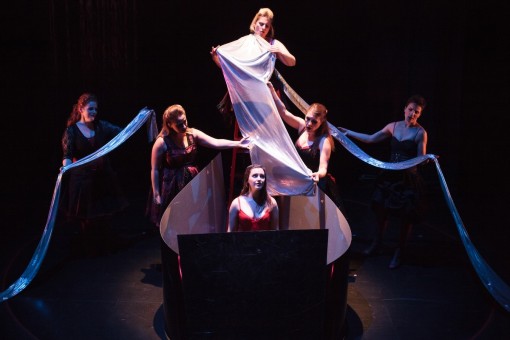Opera Philadelphia presents American premiere of mesmerizing “Svadba”
Opera companies should be presenting new operas. The risk is enormous, because many new works turn out to be duds and because a company’s most reliable audience often wants to hear the same ten operas over and over again. Enterprising organizations find ways to make it financially viable, often by bringing new works to smaller, less expensive venues.
One such success is Opera Philadelphia’s new Opera in the City series, inaugurated on Saturday night with Svadba (Wedding), an opera by Ana Sokolović. It is the company’s first presentation at FringeArts, a gritty venue along the Delaware River, in the shadow of the Benjamin Franklin Bridge.
Written in 2011, Svadba is an hour-long opera that affords a glimpse into the life of a Serbian woman, Milica, on the eve of her marriage. Five of her girlfriends get together to observe the usual rituals: drinking, playing children’s games, helping the bride prepare her hair and dress, soothing (and exacerbating) her worries, having a final laugh as unmarried friends. The composer has claimed inspiration from Stravinsky’s Les Noces, which drew upon texts from traditional Russian wedding songs. Sokolović, who was born in Belgrade in 1968 and now lives in Montreal, uses texts from similar Serbian sources.
The score is mesmerizing, interweaving the voices of the six women in dissonant clusters, murmuring patterns, strident chords, and folk song-influenced tunes. There is no orchestra, and one hears mostly just the voices of Milica and her five friends as a unit. Occasional notes dropped into the space from an unseen glockenspiel provide pitch centers for some scenes, and sounds of a gong and a sort of soft roar from a recorded track glow in the background (John Hess is credited as instrumentalist). The singers also add some instrumental sounds, using a drum in one scene and several ocarina-like instruments, worn on straps around their necks, to evoke the singing of birds in another.
Soprano Jacqueline Woodley was a fine Milica, resplendent of tone in the only real solo moment, an extended folk song that is sung without any other sound, then gradually shadowed by the other women. The ensemble — sopranos Shannon Mercer, Virginia Hatfield, and Laura Albino, and mezzo-sopranos Andrea Ludwig and Krisztina Szabó — was perfectly knitted around Woodley, sounding almost flawlessly like a single musical unit throughout the score, locked into spotless intonation and blend.
The Serbian texts, set in a series of poignant and sometimes funny vignettes, do not really tell the story of this particular wedding, but of all weddings. It was up to the singers, often communicating in rhythmic clicks, sighs, and a buzzing chatter — all indicated in the score — to tell Milica’s story, which they did remarkably well, including mocking the swaggering gestures of a group of unrefined male suitors.
Marie-Josée Chartier directed a slender but effective production, brought from The Queen of Puddings Music Theatre in Toronto, the adventurous Canadian chamber opera company that premiered the work and that, sadly, closed its doors for good this summer. The singers used six rolling lamps, sometimes covered with colored gels, as the only real props, sometimes making rhythmic sounds with cups and other objects (set and costumes, loosely based on Serbian folk dress, by Michael Gianfrancesco). Three plastic cutouts were moved around the floor and shaped into various formations. At one point, they became a bath, in which the five women poured strips of silver fabric over Milica; at another, they formed the wedding aisle, with Milica seated on top of a ladder, draped in silver and holding a red bouquet.
Conductor Dáirine Ní Mheadhra, like the singers imported from The Queen of Puddings Music Theatre, did an admirable job guiding the singers gently as they navigated the score and staging. At the conclusion of the opera, which brings to a climax all of the characters’ anxieties about the impending joys and sorrows of matrimony, members of the West Philadelphia Orchestra took the stage, playing the first of many of the Balkan dance tunes that are its specialty. The serenade accompanied the cast and audience into the outer hall, where Opera Philadelphia hosted a traditional Balkan wedding reception, complete with food and dancing.
Trying to predict if a new opera will have long-term success or failure is a fool’s errand, but this American premiere is the second production of Svadba and it will hopefully have many more. Sokolović uses music to get at the heart of what made marriage so potentially terrifying to women: the texts refer to a woman who is being married off to a “bon vivant” when she wants to marry a “hero”; girlfriends who will miss their friend; a mother who will weep at the loss of her child; a bride carried off by midnight abductors; and a bride separated from her parents and siblings, often for good. The opera is compact in its narrative structure and yet expansive in its more affecting sections, feeling both relevant and timeless.
Svadba continues through November 7. operaphila.org
